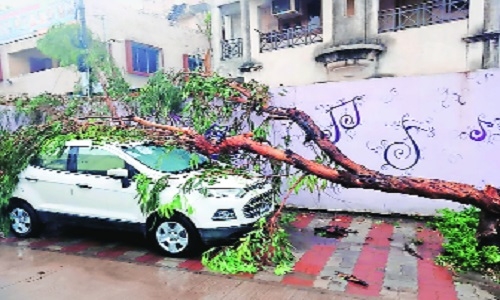Met records ZERO rainfall Despite heavy rains in South, East Nagpur
17 May 2024 08:22:13

By Kaushik Bhattacharya
South and East Nagpur on Thursday witnessed heavy downpour with severe thunderstorm for one hour from 5 pm to 6 pm that led to power-cut for hours and uprooting of trees in many localities. Despite heavy rainfall, the Sonegaon-based manual observatory of Regional Meteorological Centre (RMC), Nagpur recorded ‘zero’ mm of rainfall in city. Government departments, farmers and researchers in city depend on RMC’s weather data on a daily basis. The accuracy of weather forecasting by the Weather Department plays a major role in sowing and other agricultural activities. The Weather Department issues timely warnings for hailstorm, heavy rains for farmers. The heavy rains with severe thunderstorm on Thursday would have definitely affected farmers in the form of crop damage. But there is no data of rainfall available with the Department for Thursday evening in the city as the Sonegaon observatory recorded ‘zero’ rainfall under its observation periphery.
In recent times, Nagpur city has been witnessing many events of patchy rains which is increasing by the day. With expansion of Nagpur city, there is a need to increase the manual and automatic weather stations to record accurate weather data of the whole city. The Weather Department right now has just one manual observatory in Sonegaon and three automatic weather stations (AWS) CICR, PDKV and near Wadi. Not a single station of the city recorded the heavy rains of South and East Nagpur that wreaked havoc on Thursday. It raised a question over the capability of the department in their prediction as they are dependent on their only manual station in Sonegaon which has its own limitations and the events of patchy rains in recent time requires more weather stations to cater the accuracy in weather prediction. “Like IMD, the state government has their own observatories which also collect weather data for the city. However, it is right that there is a need to increase manual and automatic weather stations in city as Nagpur is expanding,” Praveen Kumar, Scientist C, RMC, Nagpur told ‘The Hitavada’.
“We calculate the weather data every after three hours from our existing weather stations in the city. With adoption of modern technologies we have increased our accuracy in weather prediction in recent time,” said Praveen Kumar. Despite shortfall of weather stations in the city, the weather department has no plans to increase the numbers of stations in Nagpur. Last year, Nagpur city witnessed heavy rains that caused flood in Nag river. The flood happened due to heavy downpour in the catchment area of Ambazari lake. It shows that the pattern and intensity of rainfall has changed in Nagpur city and the administration should be prepared accordingly. However, weather department’s ignorance towards increasing weather stations in the city showing their callous attitude towards their work.
“According to World Meteorological Organisation (WMO), Nagpur city had one weather observatory in Mayo Hospital in East Nagpur which was installed by the British. Even when I joined the department in 1988, the observatory working and data collection was taken place there. But due to maintenance and expansion of the hospital, the observatory was demolished,” said a senior meteorologist on a condition of anonymity. There are four departmental observatories in Vidarbha -- Nagpur, Akola, Gondia and Chandrapur -- where the staff of RMC monitors the weather data regularly. However, in the website of India Meteorological Department (IMD) it is showing only two departmental observatories that is in Nagpur and Akola. An observatory is recently opened in Bhandara which is also providing data of weather to RMC. As per the websight, RMC which covers Vidarbha, Chhattisgarh and Madhya Pradesh regions, has 17 departmental observatories of which, Vidarbha has just 2 stations. Chhattisgarh has six observatories and Madhya Pradesh has 9 weather stations.